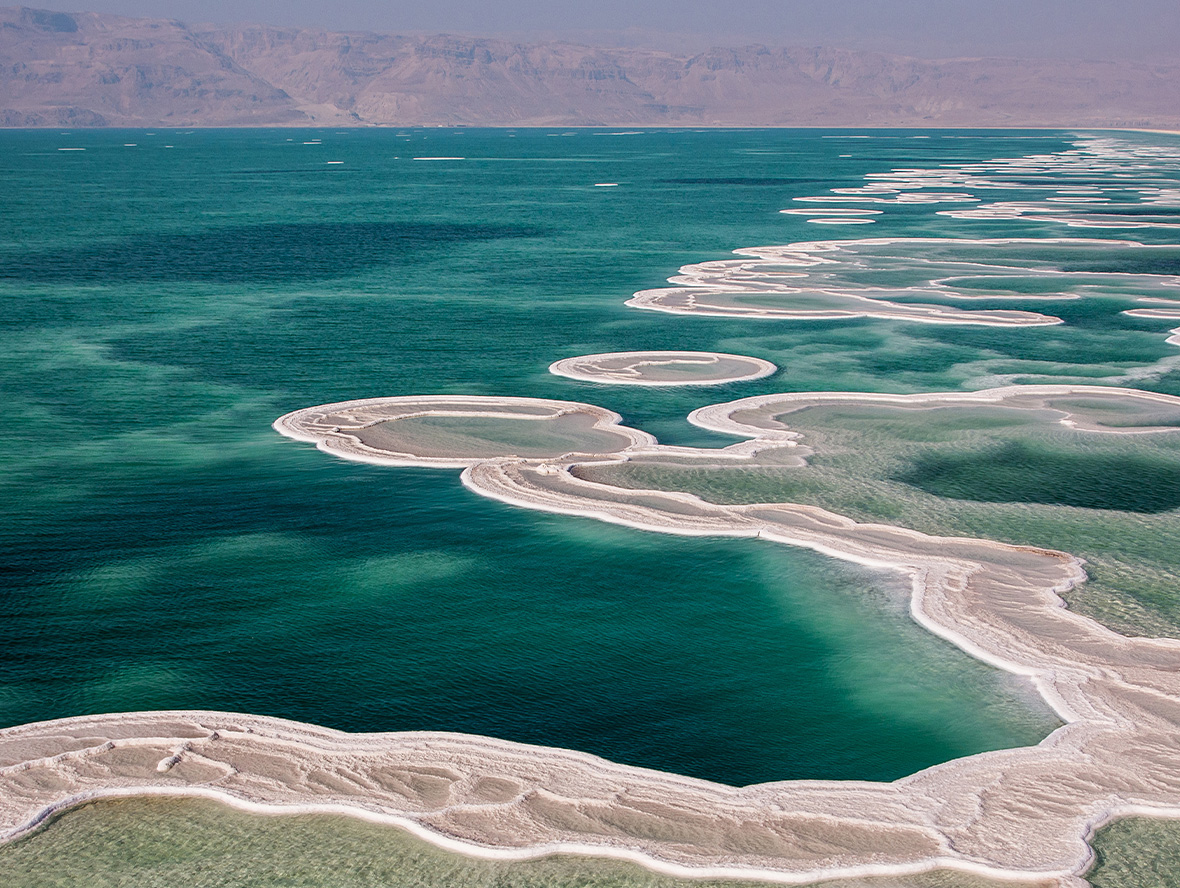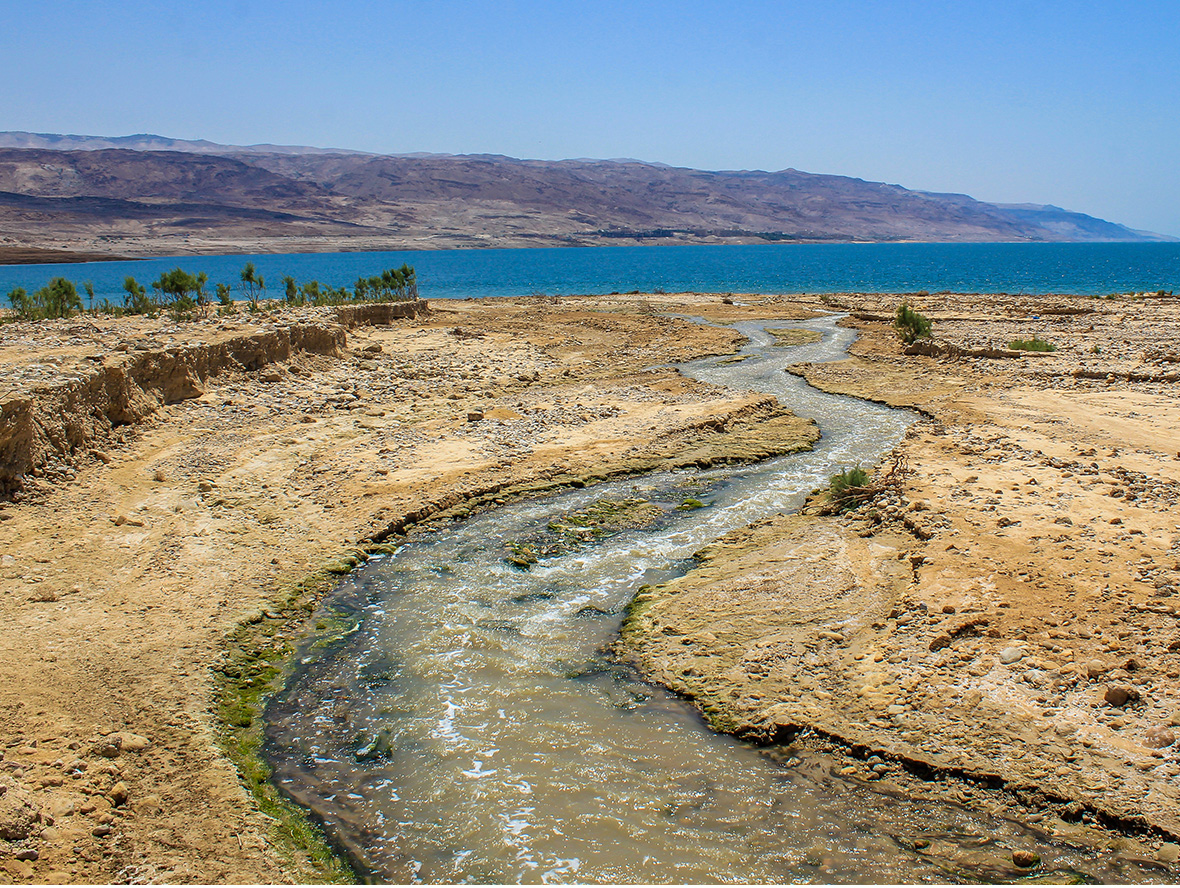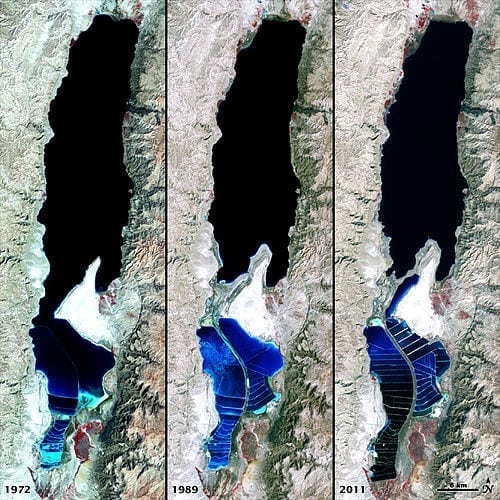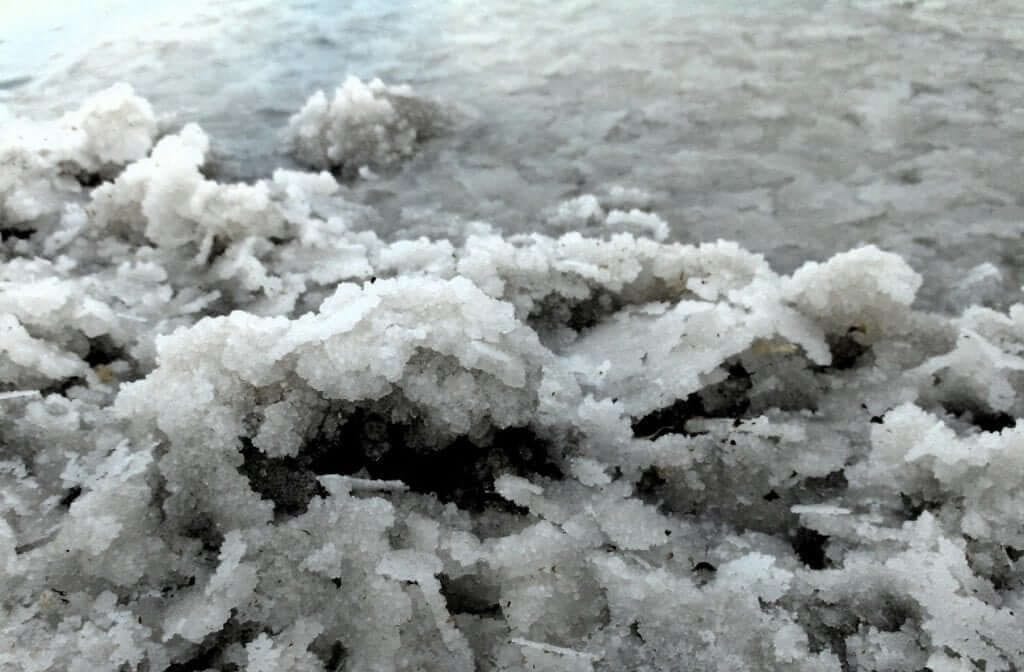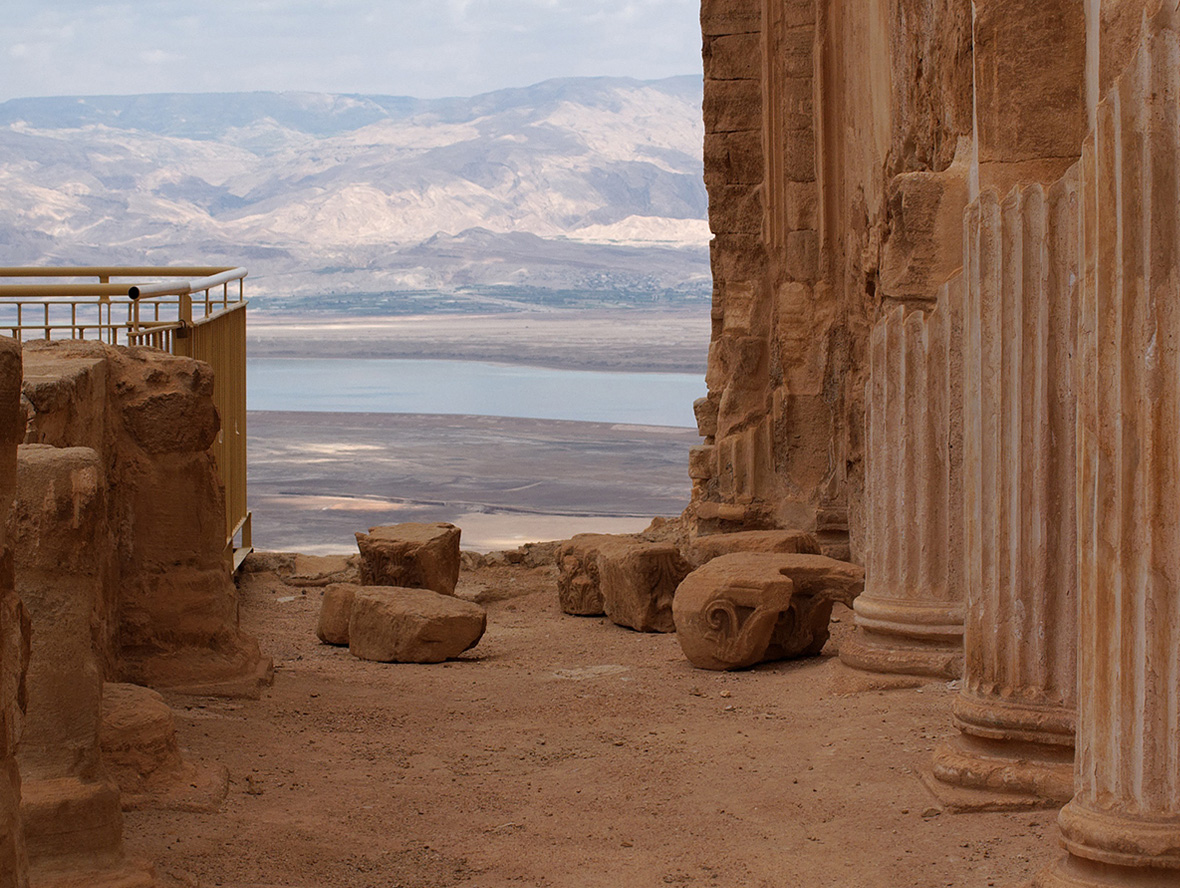At the very lowest point on earth lies a natural wonder replete with a unique ecosystem, breathtaking desert views, and mineral treasures that have been attracting visitors for thousands of years: The Dead Sea. Located in the desert in southern Israel, it is also the world’s deepest hypersaline lake. Although the high salinity of the water makes it almost impossible to dive, in this article we will delve deep into its geological origins, geography and history, become familiar with the biology and chemistry of this unique environment, and discover everything there is to do and where to stay in the area surrounding this natural gem.
Table of contents:
-
-
-
-
- What is the Dead Sea?
- Where is the Dead Sea located?
- Dead Sea Water Level
- Why is the Dead Sea called the Dead Sea?
- Is the Dead Sea Mentioned in the Bible?
- What lives in the Dead Sea?
- Why is the Dead Sea so salty?
- Why do you float in the Dead Sea?
- Is it safe to swim in the Dead Sea?
- Visit the Dead Sea
-
-
-
What is the Dead Sea?
The Dead Sea is a salt lake located in the Judean desert of southern Israel, bordered by Jordan to the East. With its origin dating back to some four million years ago, it is one of the earth’s saltiest bodies of water and is the lowest point on earth. Its arid desert climate features year-round sunny skies, and relatively high temperatures, with little precipitation.
What is so special about the Dead Sea?
The Dead Sea is located at the lowest point on earth, which is thought to be the result of volcanic processes leading to a continuous dropping of land. It is one of the four saltiest bodies of water in the world. These special conditions are an outcome of its extreme geomorphological structure alongside a harsh desert climate. These create constant dramatic changes that form a landscape that is different from any other in the world. Also, the unique mineral content of the air, land, and water in the area is globally renowned for its therapeutic qualities, as is evident in that it has been a health resort for thousands of years. Here are 10 facts about the Dead Sea that also make it unique.
How was the Dead Sea formed?
There are contending theories about the Dead Sea formation. About 3.7 million years ago, the area now known as the Jordan River Valley was repeatedly flooded by water from the Mediterranean Sea. The waters created a lagoon called the Sedom Lagoon, which connected to the sea through what is currently called the Jezreel Valley. Later on, about 2 million years ago, the land between this lagoon and the Mediterranean Sea rose to such an extent, that the sea could no longer flood the area, leading to the creation of a landlocked lake. Shifts in tectonic plates led to the rising and dropping of the floor of the valley, and the harsh desert climate led to gradual evaporation and shrinking of the lake, until finally, about 70,000 years ago, what remained was the Dead Sea with its low elevation.
What river feeds the Dead Sea?
Until the end of the 1960s, the Jordan River was the only major water source flowing into the Dead Sea, although there are small perennial springs under and around the lake, forming pools and quicksand pits along its edges. Today, after the diversion of the waters from the Sea of Galilee, the only incoming source of water is from sulfur springs and waste water, along with rare drizzles and flash floods.
What does the Dead Sea look like?
As a large body of salt water, the shores of the Dead Sea glitter with crystallized sodium chloride, where the sun evaporates the water, in colors of white and turquoise. It was formerly divided into two basins, but in the late 1970s the surface dropped significantly, and the southern basin dried out. This drop has changed the physical appearance of the Dead Sea. Most noticeably, the peninsula of Al-Lisān gradually extended eastward, until the lake’s northern and southern basins became separated by a strip of dry land. In addition, the southern basin was eventually subdivided into dozens of large evaporation pools (for the extraction of salt). Water is pumped into the southern basin from the northern basin to keep it wet. The air is redolent of sulfur, rising from its mud, which is rich in bromine. The northern beaches are full of mud, whereas the southern beaches feature interesting salt formations. The water of the Dead Sea looks almost oily due to its high salinity and density.
What are the size, length, and depth of the Dead Sea?
The Dead Sea’s geography has altered slightly throughout the years, and it is currently 50 kilometers (31 miles) long and 15 kilometers (9 miles) wide at its widest point. It is about 380 meters deep and contains about 40 billion gallons of water.
Where is the Dead Sea located?
The Dead Sea is located in southwestern Asia, on the border between Israel and Jordan. It is situated between the hills of Judea to the west and the Transjordanian plateaus to the east.
In which country is the Dead Sea located? In which city is it located?
The Dead Sea is located in southern Israel and borders Jordan. As it is deep within the desert, it is relatively far from major population centers. The desert town of Arad is a mere forty kilometers away, but the nearest major city is Jerusalem, at about an hour’s driving distance away.
Dead Sea Water Level
As a terminal lake, with no natural outlet, and no longer fed by the Jordan River and its tributaries, the Dead Sea’s water level is determined by its balance – the amount of water entering it is smaller than the quantity removed.
What is the elevation of the Dead Sea?
The Dead Sea’s water level is measured at some 430 meters below sea level, and it continues to drop by about 1 meter annually.
Is the Dead Sea the lowest place on earth?
At 430 meters below sea level, the Dead Sea is the lowest place on earth.
Is the Dead Sea drying up?
The water level of the Dead Sea has been receding gradually, at an average annual rate of about 110 cm. This causes some concern about whether the Dead Sea is drying up. The natural recession is caused mainly by evaporation under the harsh desert sun, but also because water is no longer being pumped into the Dead Sea from former sources like the Jordan River.
Why is the Dead Sea called the Dead Sea?
Due to the extreme salinity of its water, the Dead Sea is a harsh environment in which plants and animals cannot flourish.
Why do they call it the Dead Sea?
In various languages, the Dead Sea is referred to by different names, all reflective of its characteristics. The earliest known name is recorded in the Hebrew Bible, where it is referred to as “the Salt Sea”, due to its significantly high salt content. In the later Roman era, salt was a very highly valued commodity – Roman soldiers were paid in salt rather than money! This is also the source of the Latin word “salary”, which comes from “salt”.
What is the meaning of Dead Sea?
Through early translations into foreign languages continued to use the original name of “Salt Sea”, by the Roman era, visitors to Judea began calling it “The Dead Sea”, as they noticed that the waters were devoid of all life forms, whether plants or animals.
Aquatic organisms like fish and plants simply cannot thrive in the extremely saline environment of the Dead Sea, and it was named for the lack of animal and plant life. There are, however, minuscule quantities of bacteria and microbial fungi in the water. Due to its desert climate, the surrounding area is also barren, with a scarcity of plants and animals in the nearby region.
Yet another name was found in the book of Joshua in the Bible: “The Sea of the Plain”, which reflects the geography of the area: the water comes from above (the mountainous springs around, and the River of Jordan from the north) and settles into the sea on the plain.
Throughout the years, the Dead Sea has also been referred to by other names, some more colorful than others: the Primordial Sea, the East Sea, the Sea of Lot, the Sea of the Arabah, the Sea of Sodom, the Stinking Sea, the Sea of Asphalt, and the Devil’s Sea.
Is the Dead Sea Mentioned in the Bible?
There are quite a few mentions of the Dead Sea in the Bible, and it has long been associated with mysticism, wonderment, and religious significance. It has been referenced often to describe the borders of Israel but is also known in its own right. One famous reference is the story of Lot’s wife, which is set in nearby Sodom. The slopes of Mount Sodom are located in the southeast corner of the Dead Sea, and they feature salt formations that look like pillars – which are traditionally referred to as Lot’s wife.
Another famous mention is the Dead Sea prophecy, in which the prophet Ezekiel foresees a time when the Dead Sea would be transformed from saline waters that cannot host life, into fresh waters teeming with sea life.
What lives in the Dead Sea?
As can be surmised from its name, life in the Dead Sea is scarce. Its extreme salinity renders its waters uninhabitable to most higher organisms, like fish or aquatic plants. However, several types of microorganisms can survive, as they have adapted to hyper-salinity conditions. During very rainy periods, the addition of freshwater changes the chemical makeup of the water in the Dead Sea, increasing the number of microorganisms living there. There has been evidence of the water surface turning a bright red – indicating the presence of a special kind of algae.
The surrounding area of the Jordan Rift Valley serves as a migration corridor for various species, including storks and other birds of prey, as well as jungle cats, marsh frogs, toads, crabs, snails, and other water insects. The mountainous areas surrounding the Dead Sea are also a habitat for ibexes, wolves, foxes, and hyenas.
What minerals are in the Dead Sea?
The Dead Sea is globally renowned for the therapeutic effect of the minerals in its waters and mud, which are especially high in concentration. Dead Sea minerals in the water and mud have helped improve various skin conditions such as psoriasis, vitiligo, atopic dermatitis, and acne.
Why is the Dead Sea so salty?
With its very first origins in sea water flooding into the valley from the Mediterranean, some of what makes the Dead Sea salty is the gradual evaporation of water over the years, due to the desert climate. Its salt content is derived from the erosion of rocks on land, with their salt ions driven by rivers into the landlocked lake. Its extremely low elevation means that water cannot escape the Dead Sea once it enters, and exposed to the intense heat, the water evaporates more quickly, leading to an intense salinity.
Why do you float in the Dead Sea?
One of the main must-do activities on all tourists’ lists is floating in the Dead Sea. Because of the high concentration of salt, the water is much denser than plain fresh water, meaning that our body weight is lighter – which causes us to float!
Dead Sea Salt Benefits
The minerals and salts exclusive to the Dead Sea have been luring visitors for thousands of years, making it the world’s first health resort, dating back to the time of Herod. The high concentration of antiseptic minerals in the mud and salt of the Dead Sea makes it especially beneficial for skin diseases such as psoriasis and vitiligo. Covering the body in mud extracted from the Dead Sea helps the minerals become absorbed into the skin.
Dead Sea Healing Powers and Treatments
Dead Sea treatments are not only limited to the treatment of skin conditions. Other medical conditions such as arthritis and asthma have been known to benefit from the air and water of the Dead Sea. The oxygen rate is 5% higher than the surrounding area, which also enhances rejuvenation and recovery.
Dead Sea mud benefits
Those visiting the Dead Sea may witness groups of people on the beach, slathering their faces and bodies with mud. Long before soap was invented, ancient Greeks and Romans used mud to clean their faces. They realized that the salt of the Dead sea, and especially Dead Sea black mud contains an especially high concentration of salt and minerals, some of which are small enough to penetrate the pores and nourish the skin. These minerals are believed to help improve blood circulation, smooth out wrinkles and rejuvenate the skin to promote a healthy glow.
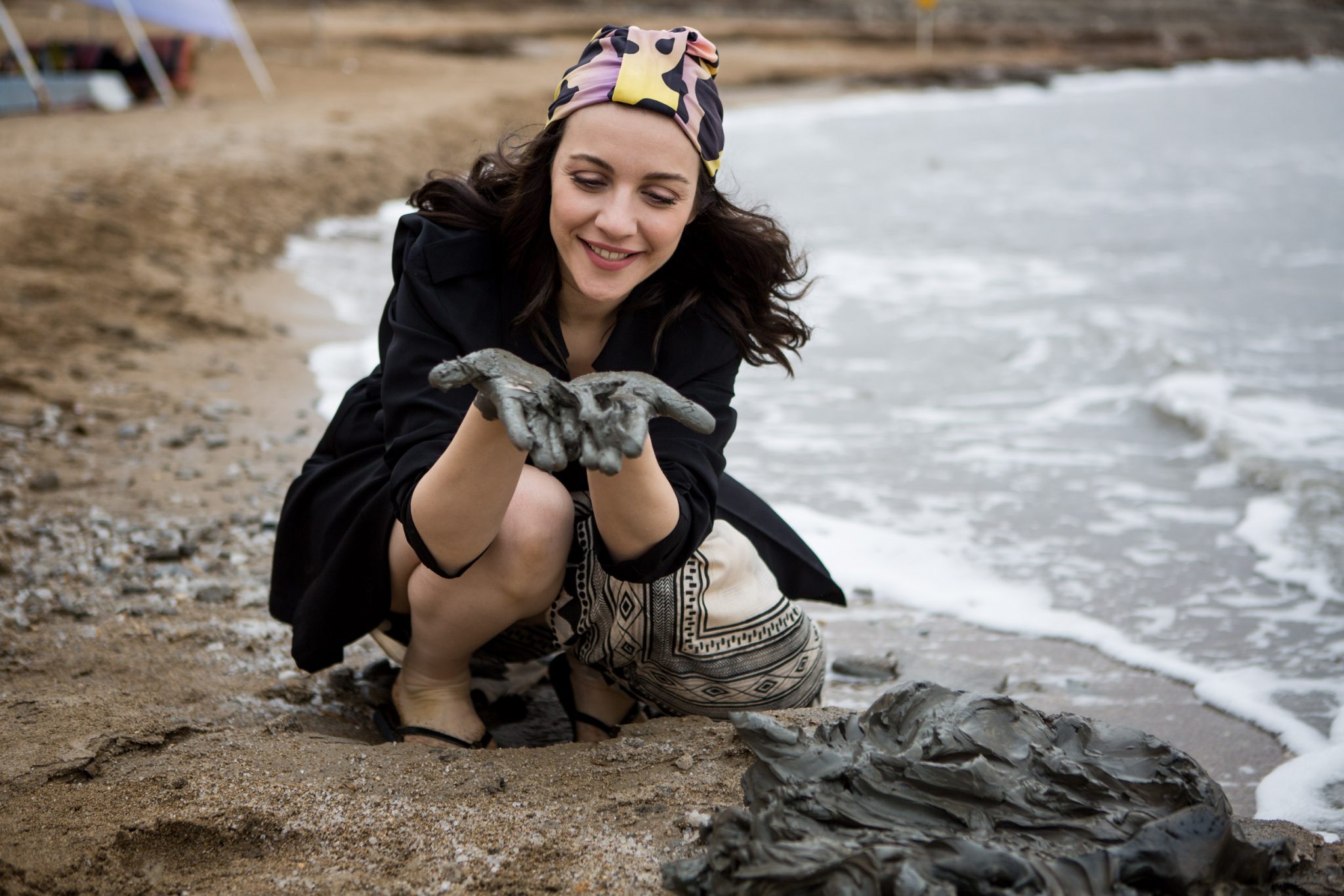
Is it safe to swim in the Dead Sea?
We know that the high salinity of water in the Dead Sea makes it very dense and oily, making the experience of swimming in the Dead Sea feel like floating. The temperature of the water is warm year-round, which makes it especially tempting to lay back and float on your back. If you follow a few basic pointers, it is safe. Remember to stay hydrated – the weather can be extremely dry and hot. You may suffer unpleasant irritation if you let water in your eyes or throat, so it’s not a good idea to dunk your head in the water. Also, if you have any cuts or scrapes, they too may irritate due to the high salinity of the water. It’s best to dip intermittently for 20 minutes or so.
Visit the Dead Sea
Have you decided to travel to the Dead Sea? Its beautiful desert environment, its unique healing qualities, and its status as an international wonder all make it a definite stop on your list. Make sure to go during the offseason, as although the weather is pleasant year-round, winters are busy with groups aiming to enjoy the healing benefits of the sun and salt, and summers are filled with local tourists. There are also plenty of activities in the surrounding areas, so come well-equipped to hike, sunbathe, ride, swim, and relax.
Dead Sea Hotels
Most of the Dead Sea is unpopulated, but visitors can find a variety of accommodations at different price levels, on the north and southern shores – from campgrounds to five-star hotels. Most of the Dead Sea hotels are located in the area of Ein Bokek, offering proximity to the beach.
Dead Sea Shore
Not all of the Dead Sea beaches are accessible to sunbathers. In the Ein Bokek area, near the hotels, there are several public beaches for an afternoon spent sunbathing. Some of these beaches offer special tourist attractions like music – it’s worth checking in advance to choose one beach or more for your upcoming visit.
Dead Sea Tourism
Its unique location, its healing properties, its geological and historical background, and its surrounding ecosystem make the Dead Sea itself an irresistible venue for tourists in the area. But if you’ve soaked up the sun and floated in the water and are wondering what to do at the Dead Sea besides all these, there are plenty of other attractions nearby. Rent a bike and explore the winding road leading along the shore. Hop into a jeep for an adrenaline-filled adventure. Explore the nearby caves of Qumran or Ein Gedi springs for a nature hike among hidden waterfalls. Or, if you are especially adventurous, climb nearby mount Masada at dawn for a sunrise you’ll never forget. Although the Dead Sea may be most famous for its healing qualities, there are loads of fun-packed days to be spent in and about the area.
The Dead Sea – A Unique Desert Gem
We often think about the Dead Sea as the lowest point on earth, but it has so much more to offer than this simple geographical fact. Whether you’re a history buff who wants to follow in the footsteps of our ancient predecessors, a nature lover out for some dramatic landscapes or you’re in search of the wealth of natural remedies offered by its air, water, and mud – the Dead Sea may not contain much life – but is an experience that should be part of yours.
Further Reading:
Anyone visiting the Dead Sea is sure to hear about Masada, the nearby mountain that was testimony to a heroic rebellion over 2000 years ago. After reading more about the famous story behind this piece of history, you will enjoy visiting the top of the mountain, whether by cable car or on foot, to see the remains of the ancient city.
The Dead Sea wasn’t the only desert location mentioned frequently in the Bible. The nearby oasis of Ein Gedi is a meeting of four freshwater rivers and served as a hiding place for King David when he fled from Saul, thousands of years ago. If you need a break from salt and mud and are looking for a refreshing hike lush with vegetation and complete with hidden waterfalls, step into your swimsuit and hiking boots and get ready for a lovely day out in nature.
If you want to get deep into the geology and science behind the formation of the Dead Sea, read more on the Dead Sea on Wikipedia. A detailed explanation of its geography can be found on Britannica, and if you’re wondering what this beautiful phenomenon looks like from outer space, be sure to check out NASA’s website for a breathtaking glimpse.

